-
 Art of Wellness Acupuncture & Traditional Chinese Medicine (TCM)11704 Wilshire Blvd, Suite 295, Los Angeles, CA, 90025
Art of Wellness Acupuncture & Traditional Chinese Medicine (TCM)11704 Wilshire Blvd, Suite 295, Los Angeles, CA, 90025
myartofwellness@gmail.com310-451-5522 Office Hours
MonClosedTue7:30 am --4 pmWed7:30 am --4 pmThu7:30 am -- 4 pmFri7:30 am -- 4 pmSat7:30 am -- 4 pmSunClosedOur office opens from Tuesdays to Saturdays 7:30 am to 4 pm, will be closed on Memorial day, Independent day, Labor day, Thanksgiving day, Christmas and New year.
-
Recent Posts
- Chinese New Year 2026: Year of the Horse
- Acupuncture and TCM Treatment for Perimenopause Symptoms
- How to Treat Insulin Resistance With Acupuncture and TCM
- How to Treat Metabolic Syndrome With Acupuncture and TCM
- How to Treat Syncope With Acupuncture and TCM
- How to Treat Thoracic Outlet Syndrome With Acupuncture and TCM
- How to Treat Dupuytren’s Contracture With Acupuncture and TCM
- How to Treat Nutcracker Syndrome With Acupuncture and TCM
- How to Treat Rosacea With Acupuncture and TCM
- How to Treat Perioral Dermatitis With Acupuncture and TCM
- Lymphatic Drainage With Acupuncture and TCM
- How to Treat Turf Toe With Acupuncture
- How to Treat Nerve Pain With Acupuncture and TCM
- How to Treat Watery Eyes With Acupuncture and TCM
- How to Treat Ovarian Cysts With Acupuncture and TCM
- How to Treat Dystonia With Acupuncture and TCM
- Sign up to receive news and updates and get my free report:“The Top 10 Reasons to Try Acupuncture”

November 2025 M T W T F S S 1 2 3 4 5 6 7 8 9 10 11 12 13 14 15 16 17 18 19 20 21 22 23 24 25 26 27 28 29 30
Traditional Chinese Medicine
How to Treat Bell’s Palsy With Acupuncture and TCM
By Qineng Tan, L.Ac., Ph.D., and Xiaomei Cai, L.Ac., Ph.D.
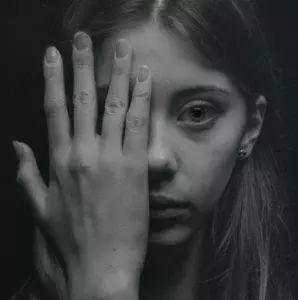
Help, I can’t move half my face! A drooping face is sometimes a sign of stroke, but more often facial droop is caused by Bell’s palsy. Bell’s palsy is a kind of neuropathy that affects the facial muscles, causing weakness or paralysis. Acupuncture and TCM offer a safe and effective method of treatment to help resolve Bell’s palsy.
Also known as idiopathic facial paralysis, Bell’s palsy comes on suddenly and worsens over the course of a day or two, often resulting in the face drooping on one side. Bell’s palsy is related to a lack of blood flow (ischemia) to the 7th cranial nerve, which may be caused by inflammation or compression. Conventional modern medicine has not fully explained what causes Bell’s palsy, but it is believed to be at least sometimes due to recent infections and/or immune responses that create inflammation in this area of the head.
Bell’s palsy affects about 40,000 people in the U.S. each year, men and women alike. People with upper respiratory problems and diabetes have a higher risk for Bell’s palsy–both conditions which can create inflammation in the cranial nerves–but it really can happen to anyone at any age.
Bell’s palsy generally resolves itself over time, which could take anywhere from a few weeks to several months. Sometimes people are left with permanent damage, though, and may have some facial weakness for the rest of their lives. Often doctors will recommend Prednisone steroid treatment as a way to help speed recovery. The TCM approach to treating Bell’s palsy with acupuncture and herbs can be helpful as either an adjunct to conventional treatment, or an alternative for those who wish to avoid steroids.
What Causes Bell’s Palsy?

Bell’s palsy occurs due to a compromisation of the 7th cranial nerve, also known as “CN7” or the “facial nerve,” which originates in the center of the skull and has five branches that extend out into all of the areas of the face: around the eyes, nose, mouth, and chin. This nerve controls communications between the brain and the facial muscles, including the tongue, and therefore controls our ability to make facial expressions, as well as being involved in tasting, chewing, and breathing. When tissues surrounding CN7 become inflamed, perhaps due to a lingering infection, it may lose some or all of its functionality due to a lack of blood flow. Viral infections that can cause swelling, or edema, in the parts of the head that affect the facial nerve include:
- Herpes zoster
- Herpes simplex
- Adenovirus
- Cytomegalovirus
- Epstein Barr
- Mumps
- Rubella
- Influenza
Diabetes, Lyme Disease, and the inflammatory disorder Sarcoidosis can also cause the sort of swelling and compression that lead to facial nerve palsy. Scientists believe that Bell’s palsy is caused in part by neurodegeneration, or damage to neurons, somewhat similar to ALS. TCM and acupuncture have been shown in clinical research to help regenerate neurons and promote the repair, growth and development of new nerve cells.
Top 10 Signs and Symptoms of Bell’s Palsy
In Bell’s Palsy, inflammation of the 7th cranial nerve causes a loss of muscle control in part of the face. If this happens to you or someone you know, first review the FAST Stroke test guidelines, to quickly assess whether or not the facial paralysis may be due to a stroke. If no other signs of stroke are present, consider whether there are signs of Bell’s palsy:
- Facial weakness or facial paralysis, affecting part or all of the face, most often face droops on one side, sometimes the lower half of the the face drooping
- Low grade fever
- Headache
- Pain behind the ear on the affected side
- Stiff neck
- Inability to close one eye
- Drooling
- Loss of sense of taste
- Heightened sensitivity to sounds on one side
- Dizziness
Occasionally, there may be pain from the swollen facial nerve. More often, though, Bell’s palsy does not cause intense pain. Pain in the face and jaw muscles is more commonly caused by Trigeminal Neuralgia, a more severe and chronic condition related to irritation or inflammation of the trigeminal nerve, which communicates messages of sensation from the face to the brain.
Medical diagnosis for Bell’s palsy will first focus on ruling out other, more serious causes of facial paralysis, like stroke. Then doctors will check for viral infections or undiagnosed diabetes, and administer an EMG, CT, or MRI to assess nerve damage.
How Does Acupuncture Treat Bell’s Palsy?
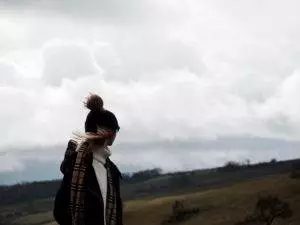
In TCM theory, we attribute health conditions to the effects of internal and/or external pathogenic forces working on the body. Bell’s palsy is considered to be the result of an invasion of wind and cold that blocks Qi (life force energy) and blood from moving through the head and face the way they normally do. Wei Qi is a specific form of energy that protects us from external pathogens, but if Wei Qi is weak (maybe due to stress, exhaustion, cold air blows directly on face, or recent illness), it can be dispersed by a strong invasion of Wind, allowing Cold to enter the head and slow things down.
This is an instance when an acupuncturist may choose to use electro acupuncture technique. Electroacupuncture uses fine needles inserted into the skin at specific points along the meridians, which are then attached to a small machine that produces an electrical impulse, so that an electrical current passes between the needles. The current of electricity is not actually entering the body, and the patient will only feel a small pulsing sensation or vibration at the site of the needles being stimulated. The muscles affected might twitch a little. This technique is sometimes called “electro stim,” and it has really only been developed in the past century, although it is still based on the same fundamental concepts of Qi that have been used in TCM for many hundreds of years. Electro acupuncture offers the advantage of being able to stimulate a point in a way that is deeper and wider than with a needle alone. We will often use electro stim acupuncture when dealing with neurological disorders. In the case of Bell’s palsy, the goal is to bring blood flow, Qi, and healing to the cranial nerve root and branches that control the facial muscles.
In some cases, Bell’s palsy does not completely resolve itself, and people are left with long-term effects. Weakness of the facial muscles that negatively impacts a person’s eating mechanisms or causes them to be unable to express themselves naturally with their facial muscles can have a real impact on quality of life and the ability to enjoy social interactions.
One study sought to test the efficacy of acupuncture treatment on patients who had been diagnosed with Bell’s palsy at least six month prior, and who were still affected by it. After several weeks of acupuncture treatment, patients reported less stiffness in the face and improved symmetry of facial features.
People who have suffered from Bell’s palsy at some point are at higher risk overall for having a stroke. One retrospective study concluded that patients who received acupuncture and TCM treatment regularly were less likely to have a stroke later on than those who didn’t.
A review of controlled trials studying acupuncture treatment versus drug therapy for Bell’s palsy showed an overall higher effective rate for the groups being treated with acupuncture.
Acupuncture Near Me for Bell’s Palsy
While Bell’s palsy is a relatively mild form of neuropathy that does often resolve itself in time, it is recommended that people do seek treatment for this condition as soon as possible. Losing muscular control of the facial muscles affects your day to day life and interactions with other people, and getting treatment can help the situation improve more quickly. With Bell’s palsy, it is important to make sure that the inflammation of the 7th cranial nerve is reduced and that whatever underlying conditions that may have contributed to the facial paralysis are taken care of, too. Otherwise, people who have had Bell’s palsy once have the potential to experience it again in the future.
*This article is for education from the perspective of Traditional Chinese Medicine only. The education provided by this article is not approved by FDA to diagnose, prevent, treat and cure human diseases. It should not stop you from consulting with your physician for your medical conditions. Traditional Chinese Medicine is based on Qi, which is an invisible force that usually cannot be observed by modern science. Because science focuses on testing ideas about the natural world with evidence obtained through observation, these aspects of acupuncture can’t be studied by science. Therefore acupuncture and Chinese herbs are often not supported by double-blind, randomized trials, and they are considered alternative medicine therapies in the United States.
How to Treat Gout With Acupuncture and TCM
By Qineng Tan, L.Ac., Ph.D. & Xiaomei Cai, L.Ac., Ph.D.

Sudden, intense pain and swelling in the big toe? Foot, ankle, knee, or elbow is red, hot, swollen and very painful? It may be a type of arthritis called gout that is caused by unusually high uric acid levels in the body. TCM methods have been used to effectively manage gout with acupuncture and herbs for thousands of years.
Gout, sometimes called gouty arthritis, is a kind of arthritis that develops over time due to other underlying conditions. When there is a sudden flare-up that creates a lot of pain and swelling in a joint, it is called an acute attack of gout. Gout is almost always related to a person’s diet and lifestyle, and part of any treatment plan is reducing intake of beverages and foods that cause gout.
Conventional treatment for gout involves first allowing the acute attack to subside, then using medications and monitoring to bring down high uric acid levels. Acupuncture and TCM have been shown in clinical studies to be even more effective at providing immediate gout pain relief and bringing down uric acid levels than typical drug therapies.
What Is Gout?
Gout is a very painful form of inflammatory arthritis caused by the buildup of uric acid crystals in a joint, often the big toe joint. Uric acid is formed as a byproduct of digestion; when the body breaks down purines–chemicals in certain foods–the resulting uric acid is processed by the kidneys and leaves the body in liquid waste. If too much uric acid is being produced, or if the kidneys are weak and unable to process it adequately, the level of uric acid in the bloodstream rises (hyperuricemia), and deposits of uric acid crystals begin to gather in the joints. These crystals have sharp edges, which are what cause the severe pain and swelling of a gout attack.
While older men are generally at higher risk for developing gout, gout can affect people of all ages and genders. Women are more likely to develop gout after menopause, when their uric acid levels tend to rise. People who are high risk for gout are those who already suffer from:
- Obesity
- Diabetes
- Heart failure
- High blood pressure
- Kidney disease
People who have a family history of gout, or who tend to eat a lot of meat and/or drink a lot of alcohol also face a higher risk for gout. Regular use of diuretics can precede attacks of gout.
The symptoms of gout can be very similar to those of other types of arthritis, but gout causes are different than those of rheumatoid arthritis. Thus is it important to seek help from your health care providers for diagnosing rheumatoid arthritis versus gout.
Top 5 Signs and Symptoms of Gout

The underlying condition that causes gout is related to the kidneys, but the actual experience of gout is a form of acute inflammation, usually in one of the smaller joints of the limbs or extremities– most often there is gout in feet, especially the big toe joint. A person may have hyperuricemia for a long time, causing uric acid buildup in the body, but it doesn’t actually become “gout” until there is a flare-up of painful symptoms. The signs of a gout attack are:
- Intense pain in a joint (gout in big toe, gout in foot, gout in ankle, gout in hands, heel pain are all common)
- Redness
- Swelling
- Tenderness to even a slight touch
- Hot to the touch
Diagnostics for gouty arthritis include blood tests to check for uric acid levels, or extraction of fluids from the joint to check for uric acid crystals. Signs of gout in the joint may also show up in x-rays, or in an ultrasound or CT scan.
What is the Medical Treatment for Gout?
There are two components to conventional medical gout treatment: treatment for immediate gout pain relief, to reduce the pain and swelling of an acute attack of gout, and treatment to prevent a future gout attack by reducing the levels of uric acid in the blood.
For pain and swelling, most patients with gout are recommended NSAIDS for pain relief. People who cannot take NSAIDS due to stomach ulcers or kidney problems are often given corticosteroid injections in the affected joint. Many patients are also prescribed a drug called colchicine, which works by disrupting a specific inflammatory response in the body, which can help to reduce the formation of uric acid crystals. The rate of colchicine side effects such as nausea, vomiting, diarrhea, and stomach pain is fairly high.
To stabilize blood uric acid levels, there are medications that block the production of uric acid (Lopurin, Zyloprim, Uloric) and medications that break down and/or remove uric acid (Benemid, Zurampic, Krystexxa). These medications have to be carefully managed according to changes in uric acid formation and kidney function, as well as possible interactions with other medications. Many people who have gout also have heart problems or high blood pressure. This type of medical treatment for preventing and controlling gout often goes on for years, or even for the rest of a person’s life. Unfortunately, because it can be so difficult for both doctor and patient to keep up with monitoring, taking medication consistently, and changing dosages frequently, this sort of medical treatment often doesn’t work to prevent more gout attacks.
Can Acupuncture Help Gout?
TCM theory designates several internal pathogenic processes that can occur within the organ systems. TCM views gout as a problem of dampness and heat, and/or stagnation and buildup of phlegm in the joints. As we mentioned earlier, many, if not most, people who suffer from gout also have other health problems like hypertension or diabetes. So, the TCM provider is also looking at the root causes of those health issues and will treat those with acupuncture and herbs at the same time. The goal of acupuncture and herb supplementation is always to bring the all of the organ systems back into harmony. TCM herbs to help gout will work to strengthen the spleen, kidneys, and liver, clear heat and dampness, and improve blood circulation.
A systematic review of studies relating to TCM treatment of gout with acupuncture showed that patients receiving acupuncture and herbs fared better overall than those in the control group being given typical medical therapy. The studies measured the “resolution” of an attack of gout; meaning, whether or not the pain and swelling was completely reduced within a 24-hour period. They also measured the reduction of uric acid levels in the blood before and after treatment. According to both measures, patients who received TCM treatment for gout had better results than those taking western medicines like colchicine or allopurinol.
A controlled clinical trial conducted at a research hospital showed a 92.5% efficacy rate for treating an acute gout attack, versus an 82.5% efficacy rate for patients who were given NSAIDS to treat the pain.
Top 5 Home Remedies for Gout According to TCM

First and foremost, it is necessary to plan and follow through on an appropriate gout diet: knowing what foods to avoid with gout is vital to prevent future attacks.
- Avoid Foods that cause Gout – foods that are high in purines include red meat, organ meats, seafood and alcoholic beverages, including beer, wine, and liquors. Risk for gout rises dramatically when people drink 2-4 or more alcoholic beverages per day. This may be because the body has to prioritize processing the alcohol over removing uric acid.
- Avoid sugar – Especially sugary drinks like sodas, and sweetened juices. Fructose appears to be particularly linked to higher incidence of gout, so read labels and avoid products sweetened with fructose or high fructose corn syrup.
- Avoid refined flours and yeast – the combination of yeast, white flour, and white sugar does not provide much nutritional value, and can raise uric acid levels.
- Emphasize whole, natural foods – all fruits, vegetables, and legumes are safe to eat with gout. Eggs and low-fat dairy products are safe sources of protein.
- Drink more water – this helps your body to more effectively flush out excess uric acid.
Exercising more and working on healthy, gradual weight loss will also help to prevent future gout attacks. Your acupuncturist can help you to develop a specific gout diet that will work for your constitution.
Acupuncture Near Me for Gout
While treating gout can be tricky due to the fact that it is usually not the only health issue that needs attention, the good news is that gout is one of the few types of arthritis that can be reversed. A holistic approach that takes into consideration a person’s diet, lifestyle, and other health problems is the best way to keep the intense pain of gout at bay. Acupuncture and TCM offer a solid alternative treatment method that can relieve gout and improve your overall health, all without unwanted side effects.
*This article is for education from the perspective of Traditional Chinese Medicine only. The education provided by this article is not approved by FDA to diagnose, prevent, treat and cure human diseases. It should not stop you from consulting with your physician for your medical conditions. Traditional Chinese Medicine is based on Qi, which is an invisible force that usually cannot be observed by modern science. Because science focuses on testing ideas about the natural world with evidence obtained through observation, these aspects of acupuncture can’t be studied by science. Therefore acupuncture and Chinese herbs are often not supported by double-blind, randomized trials, and they are considered alternative medicine therapies in the United States.
Chinese New Year 2021 Year of the Ox
By Qineng Tan, L.Ac., Ph.D. & Xiaomei Cai, L.Ac., Ph.D.
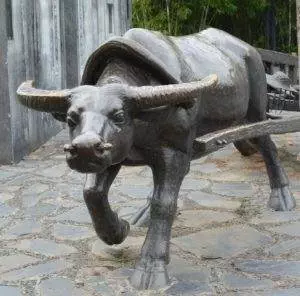
The Chinese New Year celebration will begin on February 12, 2021 this upcoming year. Throughout Asia, the start of the new year according to the lunar calendar is the most exuberant holiday, the time when families gather together to give gifts, eat special foods, honor long-held traditions, and show their love for one another. All around the world, the 2021 New Year holidays will look different, and many families will have to share their New Year greetings from afar. However, the new energy of the Metal Ox, according to Chinese Astrology, offers a way to view our situation with hope and purpose.
In Western astrology, your sun sign derives from the time of the year and place where you were born; whereas in Chinese Astrology, people who share an entire birth year also share a birth sign. The Chinese Astrological calendar runs through a twelve-year cycle.
The Ox is the second of the Chinese zodiac animals, following the Rat, who has been representative of 2020. (Looking back, we can see how the Rat’s frantic energy led to multiplying numbers, and tendencies to hoard.) Like this past year, ruled by the Metal Rat, the Ox is still influenced by the Metal element, which brings strength and steely resolve, but also rigidity, and a tendency to try to do things alone. The Ox, also known as the Cow, is all about hard work and persistence, so the Metal energy is complementary at a time when people, as individuals and as a global community, must work through intense difficulties with the ultimate diligence.
In TCM, the Metal element is considered to be connected in particular to the lungs and respiratory system. It cannot be overemphasized; top priority for the upcoming year must be taking care of your health, protecting and strengthening your Wei Qi (the Qi that helps prevent colds and flus), and getting plenty of rest. If you do not already have a regular practice of deep breathing and meditation in place, now is the time to begin.
Metal Ox, sometimes thought of as “Gold Ox,” or “Iron Ox,” is good at developing relationships, but does so with total, and sometimes brutal, honesty. She will demand truth and righteousness from others, too. In 2021, we have an opportunity to find new ways to build community even as we contemplate a world that feels more isolating than ever.
The metal Ox cannot be manipulated, but will charge straight ahead to tackle obstacles. Ox is ready to be tested; in fact, she relishes the chance to prove herself. On the other hand, Ox can be stubborn and unwilling to listen to alternative ideas that might call for a change of plans. Metal Ox is ready to put in the hard work, not because she seeks reward or accolades, but because without consistent effort, she knows nothing will get done or change. The overall energy of the Metal Cow is Yin, and associated with the cold months of Winter, when seeds and bulbs are buried underground, waiting and developing in quiet darkness.
Chinese Astrology, like Traditional Chinese Medicine, and Chinese philosophy in general, views the world through microcosm and macrocosm. That is, we see the entire universe represented in every living creature; and each individual, by creating harmony within, can help to create harmony in the universe as a whole. As we move into 2021, it feels especially necessary that we all take care of our bodies, our families, our communities, and by doing so, we extend that sense of taking care out to the whole world.
Top 3 Tips for Good Luck in the New Year
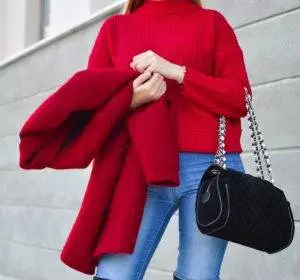
Are you an Ox? If so, this year is your “ben ming nian!” Literally translated as the “year of original destiny,” this is the term for when it is “your year;” in other words, the Zodiac sign matches that of the year you were born. It is generally believed that your ben ming nian can be a tumultuous year with a lot of ups and downs. People who want to ensure good luck during their Zodiac Year practice these habits for good fortune:
- Wearing Red – the color red is believed to chase away bad luck, so wearing even a little bit of red – red socks, red underwear – daily is advisable when it is your ben ming nian. However, there is one important point to remember; the red item must be given to you as a gift–not something you buy for yourself. So, now you know what to put on your holiday wish list if you’re an Ox: red accessories!
- Carry or Wear Jade – jade also has protective qualities, and is believed to help bring peace, harmony, and abundance to the wearer. It is common to see people always wearing a favorite pendant or bracelet made of jade.
- Avoid Facing “Tai Sui” – In Chinese Astrology, Tai Sui is a star that opposes Jupiter in the sky, and represents the “God of Age.” Some signs, including the ben ming nian, are in conflict with Tai Sui each year. Feng Shui principles give instructions as to how people who need to avoid “offending” Tai Sui can arrange their furniture so as not to cause unfortunate clashes.
Whatever your sign, the New Year is always a time to clean the house thoroughly, settle all accounts, and get organized so that the beginning of the year truly represents a fresh start.
Find Your Sign in Chinese Astrology

Because your Chinese sign is determined by the Lunar calendar, be sure to check the exact dates of your birth year. People born in January or February may belong to the former or later year.
- Ox 1937, 1949, 1961, 1973, 1985, 1997, 2009
- Tiger 1938, 1950, 1962, 1974, 1986, 1998, 2010
- Rabbit 1939, 1951, 1963, 1975, 1987, 1999, 2011
- Dragon 1940, 1952, 1964, 1976, 1988, 2000, 2012
- Snake 1941, 1953, 1965, 1977, 1989, 2001, 2013
- Horse 1942, 1954,1966, 1978, 1990, 2002, 2014
- Goat 1943, 1955, 1967, 1979, 1991, 2003, 2015
- Monkey 1944, 1956, 1968, 1980, 1992, 2004, 2016
- Rooster 1945, 1957, 1969, 1981, 1993, 2005, 2017
- Dog 1946, 1958, 1970, 1982, 1994, 2006, 2018
- Pig 1947, 1959, 1971, 1983, 1995, 2007, 2019
- Rat 1936, 1948, 1960, 1972, 1984, 1996, 2008
Seeds for the New Year Grow Into Conversations
At New Year’s parties–indeed, at any sort of gathering–you are bound to see a big bowl of unshelled sunflower seeds on the table. In China, people have been preparing seeds to be eaten as a shared snack for centuries. During the Yuan Dynasty (13th-14th century), people would stir-fry and eat melon seeds. Even though nowadays people almost always eat sunflower seeds instead, the common phrase for doing so in Chinese, 吃瓜, is still translated literally as “eating melon seeds,” or even simply “eating watermelon.” This phrase can also mean “gossiping,” because people love to nibble on the seeds while they chat with their friends and relatives.

Traditionally, the seeds are cooked inside their shells, and the shells are left on, which helps them stay fresh longer (about six months), but it also means that they take longer to eat. This is why the habit naturally accompanies long, leisurely talks with friends and family. You can sit for hours, cracking the seed casings open with your teeth one by one, enjoying an activity that occupies your hands and mouth, without actually eating too many seeds.
According to TCM nutrition guidelines, sunflower seeds belong to the category of bitter foods, and are fairly neutral, in terms of yin and yang energies. Baking or frying seeds adds more heat energy, while boiling helps preserve the nutrients better. Sunflower seeds are high in fat, which is what makes them so tasty, so do be sure to enjoy them in moderation, with only a light sprinkling of salt, and lots of good, easy-going conversation!
Best Wishes From All of Us at Art of Wellness
There are many ways to wish friends and loved ones a Happy New Year in Chinese. This year, we want to say to all of our patients and friends: 祝财运亨通 Zhù cáiyùn hēngtōng! I want to wish you longevity and health!
*This article is for education from the perspective of Traditional Chinese Medicine only. The education provided by this article is not approved by FDA to diagnose, prevent, treat and cure human diseases. It should not stop you from consulting with your physician for your medical conditions. Traditional Chinese Medicine is based on Qi, which is an invisible force that usually cannot be observed by modern science. Because science focuses on testing ideas about the natural world with evidence obtained through observation, these aspects of acupuncture can’t be studied by science. Therefore acupuncture and Chinese herbs are often not supported by double-blind, randomized trials, and they are considered alternative medicine therapies in the United States.
How to Treat Hyperthyroidism With Acupuncture and TCM
By Qineng Tan, L.Ac., Ph.D., & Xiaomei Cai, L.Ac., Ph.D.
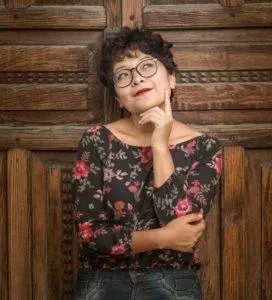
Changes in mood, appetite, hair, and skin? Wondering whether these could be signs of menopause; or could it be a thyroid problem? The symptoms of hyperthyroidism are often similar to what we think of as typical signs of menopause. Acupuncture treatment has been shown to be effective at helping to manage many types of endocrine system conditions, including hyperthyroidism, Graves’ disease, and Hashimoto’s thyroiditis.
Hyperthyroidism, sometimes called “overactive thyroid,” refers to a set of various disorders in which the thyroid gland produces excess hormones. This leads to thyrotoxicosis, a condition in which there is too much thyroid hormone in the body. Sometimes this is indicated by a visible swelling of the thyroid gland in the front of the neck, known as a “goiter.”
Thyroid disorders are much more common in women than in men, and they often develop in young adulthood, between the ages of 20 and 40. However, people of any age can show signs of hyperthyroidism. In older adults, the symptoms of an overactive thyroid can be subtle, and easily confused with those of other hormonal imbalance conditions such as perimenopause symptoms and diabetes. It can often be difficult and take years for patients to be diagnosed with a thyroid disorder, and then to find the right treatment to solve their problem. Hyperthyroidism can have different root causes, and treating it effectively requires finding the correct source of the problem.
It is important to address thyroid problems because hyperthyroidism increases the risk for heart disease and osteoporosis. There is some evidence that people with Graves’ disease are at higher risk for developing thyroid cancers. Acupuncture has been shown to be a safe and effective alternative or adjunct treatment for all kinds of thyroid disorders. The TCM approach can help correct the symptoms of excess thyroid hormone by restoring balance at the source of the problem.
Top 5 Causes of Hyperthyroidism
Several different factors can lead to enlargement or inflammation of the thyroid and the overproduction and output of thyroid hormones. Some causes of hyperthyroidism include:
- Hyperthyroidism can develop due to nodules or a multinodular goiter on the thyroid gland, which causes it to secrete extra hormones.
- Thyroiditis, swelling of the thyroid gland, can linger after a viral infection. Some thyroid problems are caused by autoimmune disorders.
- Graves’ disease causes antibodies to mistakenly attack the tissue of the thyroid, causing inflammation and overproduction of thyroid hormones.
- The thyroid gland uses the mineral iodine to make thyroid hormones, so sometimes hyperthyroidism is linked with too much iodine in the diet, often due to the use of certain supplements.
- Sometimes people are prescribed hormone replacement medications, and taking too much of them leads to hyperthyroidism.
Hashimoto disease also attacks the thyroid gland, but in that case, it causes the thyroid to stop producing enough hormones, leading to hypothyroidism.
Top 10 Signs of an Overactive Thyroid

The thyroid gland is located on the lower front of the neck, beneath the larynx, or voice box. Check for signs of swelling that might indicate an enlarged thyroid (goitres) by watching in a mirror as you tilt your head back slightly and swallow a mouthful of water. If you notice any bulging, have it checked by a doctor.
Other signs and symptoms of hyperthyroidism include:
- Nervousness or anxiety, a “hyperactive” restless feeling
- Fast or irregular heart rate
- Irritability
- Unexplained weight loss, constant thirst and hunger
- Having to urinate frequently and/or loose bowels
- Difficulty sleeping
- Itchiness or “twitching”
- Sensitivity to temperatures, excessive sweating, red hands
- Swelling in the neck
- Loss of libido
As you can see, many of these are often associated with menopausal symptoms: feeling hot and sweaty (hot flashes), low libido (vaginal atrophy or dryness), irritability/sensitivity, sleep problems, etc.
When hyperthyroidism is caused by an autoimmune disorder, there is often noticeable bulging or protrusion of the eyes. This is called Graves’ ophthalmopathy, Graves’ eye disease, or Thyroid Eye Disease (TED). This happens because some of the tissues around the eye are chemically similar to those of the thyroid gland, and the immune system is attacking those cells, resulting in inflammation around the eye. This can cause blurry vision, dryness because the lids can’t close fully over the eyeball, and headaches because of pressure behind the eyes. Changes in hair texture or loss of hair are another sign of Graves’ disease.
Hormone Testing for Thyroid Problems
The endocrine system is very complex and relies upon the harmonious functioning of several different endocrine glands producing hormones that work in concert to maintain stability of a person’s whole life process: waking, sleeping, self-regulating temperature, eating and digesting, and many other more subtle processes. The proper working of the thyroid gland is in close relationship with the pituitary gland and the hypothalamus, both located in the brain.
The thyroid gland produces various hormones which have to do with growth, metabolism, and reproduction, including thyroxine (T4) and triiodothyronine (T3). The pituitary gland produces TSH (thyroid stimulating hormone), which triggers production of the thyroid hormones T4, T3, and others. Thus the pituitary gland is responsible for gauging how much thyroid hormone is flowing through the body in the bloodstream, and making adjustments as necessary.
When a thyroid problem is suspected, the first kind of testing done is usually a TSH blood test. A TSH test showing a high TSH level would suggest that thyroid hormone levels are low, and that the pituitary gland is making more TSH to try to stimulate production, while a low TSH would indicate that the thyroid may be producing too much hormone, and the pituitary gland is trying to slow down production. Either kind of abnormal TSH level might lead to more specific testing to determine levels of T4, “free T4 (FT4),” or T3.
Medical treatment for hyperactive thyroid depends on what is causing the problem. If the thyroid is producing too much hormone “autonomously,” that is, if there are normal TSH levels and the pituitary gland seems to be functioning, then radioactive iodine is usually employed to bring down the thyroid hormone levels. When the problem is an autoimmune problem, as in Graves’ disease, a course of “anti-thyroid” medication, such as thiamazole, may bring the hormone levels back to normal. An enlarged thyroid gland may indicate a surgical solution.
Can Acupuncture Help Thyroid Problems?

In TCM philosophy, most disease stems from imbalances in the key energies of the body and spirit. “Qi” a life force energy that flows along pathways through the body called “meridians,” must be kept strong and flowing freely; if Qi is weak, or the meridians are blocked, certain organs will not get the nourishment they need, and illness will result. Yin and Yang are two energies that work together in opposition to maintain balance, like a scale. If either Yin or Yang becomes dominant, the other one becomes weaker, and there will be problems of “deficiency” and/or “excess.”
In the case of an overactive thyroid, the constant striving of Yang energy creates a deficiency of Yin, and the overall Qi energy is also weakened. The hyperactive energy of hyperthyroidism is interpreted through TCM as being related to heat, and especially too much fiery energy from the liver. We view blockages as being related to stagnation of Qi, or blood, or phlegm. In this case, phlegm stagnation is impeding the flow to and from the thyroid gland.
- Liver heat causes symptoms like: redness of the skin, itchiness, irritability, hunger and high metabolism, and a quickened pulse.
- Weakness of Qi and Yin causes: trouble breathing, trouble sleeping, sweating, and dryness of the eyes and mouth.
- Phlegm stagnation is considered the reason for the swelling of the thyroid gland itself.
TCM treatment for hyperthyroidism uses acupuncture and individualized herbal formulations to clear heat and phlegm, strengthen Qi and Yin, and cool down liver fire and overworked Yang.
One study showed improvement in hyperthyroid symptoms of over 88% of patients after having received a course of acupuncture, with some patients making full recoveries. A study that focused on the use of a specific Chinese herb formulation in addition to methimazole medication for patients with Graves’ disease concluded that TCM herbs were effective as an adjunct treatment for helping to bring FT3, FT4, and TSH levels back to normal.
Acupuncture Near Me for Hyperthyroidism
Disorders of the thyroid and the endocrine system in general, especially those that are related to autoimmune disorders, can be very challenging to manage. At Art of Wellness, we have over 30 years of experience dealing with all types of hormone imbalances. The TCM approach offers a highly personalized course of treatment for hyperthyroidism, which can be a valuable adjunct to conventional medicine. If you or someone you know suspects they may have an overactive thyroid, consider consulting with a qualified acupuncturist as part of your health care plan.
*This article is for education from the perspective of Traditional Chinese Medicine only. The education provided by this article is not approved by FDA to diagnose, prevent, treat and cure human diseases. It should not stop you from consulting with your physician for your medical conditions. Traditional Chinese Medicine is based on Qi, which is an invisible force that usually cannot be observed by modern science. Because science focuses on testing ideas about the natural world with evidence obtained through observation, these aspects of acupuncture can’t be studied by science. Therefore acupuncture and Chinese herbs are often not supported by double-blind, randomized trials, and they are considered alternative medicine therapies in the United States.
How to Treat Asthma With Acupuncture and TCM
By Qineng Tan, L.Ac., Ph.D. & Xiaomei Cai, L.Ac., Ph.D.

Difficulty breathing? Could it be seasonal allergies, or could I have asthma? Asthma symptoms include shortness of breath, wheezing, and an allergy cough that is usually more pronounced in the morning and evening. Acupuncture and TCM have long been recognized as offering effective treatment for allergic rhinitis (hay fever) related to asthma.
Asthma, a chronic lung condition which creates inflammation of the airways of the respiratory system, often begins causing breathing problems in childhood. In fact, asthma is the most common chronic disease affecting children worldwide. Sometimes asthma symptoms go away as a child grows up, but asthma can affect both children and adults long-term.
What is an asthma attack? An asthma attack occurs when the bronchial tubes become constricted. The tightening of muscles around the bronchi, combined with inflammation on the inner walls of these airways, causes shortness of breath, chest pain, coughing, and wheezing. Asthma attacks can be profoundly frightening; sometimes people describe the experience as feeling like they’re drowning.
Allergy triggers like dust mites and ragweed often cause asthma symptoms to flare up. Asthma attacks are often triggered by the same sorts of things that cause other types of allergic reactions: high pollen counts, pet dander, chemical perfumes, or smoke. An asthma attack can also be caused by changes in temperature, strong aerobic exercise, or a bout of intense crying or laughing. A viral respiratory infection can also trigger asthma.
Asthma attacks due to seasonal allergies are often managed by conventional medicine with inhalers, corticosteroids like methylprednisolone, or antihistamines like Zyrtecs. Usually doctors will prescribe a medication intended for long-term management of symptoms, and a “rescue inhaler” designed to stop an asthma attack in progress. Allergy medications can help relieve hay fever symptoms like itchy eyes and sneezing and help prevent a full-blown asthma attack, but they do not address the immune system imbalances that are the root cause of asthma and allergies. Acupuncture treatment used in addition to standard medical remedies for asthma has been clinically shown to help reduce symptoms and improve overall quality of life. Along with helping people maintain their normal activities and sleep better, TCM methods used in conjunction with conventional medical therapy can reduce the need for trips to the emergency room or hospital for asthma attacks.
Can asthma be cured? Asthma may never go away completely, but it can be managed so effectively that it no longer has a negative impact on your life.
Top 5 Asthma Symptoms
Asthma symptoms often begin appearing during childhood, but asthma can come on at any age. When a person develops asthma later in life, it is called “adult onset asthma.” Sometimes people don’t realize they have asthma because they aren’t experiencing what they think of as the classic “asthma attack.” A persistent cough, especially one that gets worse at night, is actually one of the most pervasive symptoms of asthma. Other symptoms of asthma include:
- Coughing frequently, allergy cough
- Wheezing (that whistling sound when you breathe)
- Shortness of breath (having trouble drawing a full breath)
- Rapid breathing
- Chest tightness, breathing chest pain
Why is asthma worse at night? The precise reason for the increase of asthma symptoms during the night, known as “nocturnal asthma,” has not been medically proven, but it is probably due to a combination of factors:
- Cooler air entering the bronchial passages
- Increase of allergens like pollen in the air
- Exposure to dust mites or pet dander in the bed
- Reclining sleep position makes it harder to breathe
- Hormone secretions that occur during sleep
Nighttime asthma can really affect your ability to get enough quality sleep.

Many of the symptoms of asthma are similar to those of an allergic reaction. However, seasonal allergies usually also cause symptoms like: head congestion, runny nose, itching inside the mouth, throat, and ears, sinus pain, and postnasal drip. Asthma doesn’t cause these sorts of upper respiratory symptoms because it is a condition of the lungs and bronchial tubes.
In order to make a definitive diagnosis of asthma, a doctor will usually perform tests that determine your lung function. A spirometer is a tool that helps determine how much air you are able to inhale and exhale. If you are able to inhale better after being given medication from an inhaler, then it will be concluded that you probably have asthma. An x-ray can show whether the bronchial tubes are blocked and determine whether there might be some other cause for lung damage, such as pneumonia or tuberculosis. Often people will also be given allergy testing to determine what triggers may affect their breathing.
Can Acupuncture Help Asthma?
Asthma has been recognized by TCM since ancient times. We call asthma “Xiao Chuan,” which means “wheezing, breathlessness.” According to TCM theory, the lungs control inhaling, while the kidneys control exhaling. Lung Qi (energy) should move downward, while Liver Qi should move upward, and these energies work in harmony. Asthma is the result of one or all of these energies entering into a state of imbalance or deficiency. Excess wind and/or phlegm get trapped in the lungs and airways, creating obstructions and producing the wheezing and shortness of breath associated with asthma. Acupuncture treatment focuses largely on strengthening the kidneys and lungs, and clearing phlegm and wind from the system.
One study determined that acupuncture treatment reduced “respiratory resistance,” helping to open up the bronchial tubes. A study in Denmark focused specifically on young children with asthma showed that symptoms and need for medications was reduced significantly after ten acupuncture treatments. A systematic review of nine studies involving patients using TCM as a complementary therapy in addition to conventional treatment showed an overall improvement in asthma symptoms and concluded that acupuncture should be considered as an adjunct to medications.

As always, herbal supplementation is also a crucial component of TCM treatment for asthma and allergies. Research has shown that classic TCM herbal formulations for asthma provide many therapeutic benefits, including: reducing hyperreactivity in the bronchial tubes, reducing inflammation of the lungs and tubes, and calming muscle contractions around the airways. One study specifically focused on children with asthma concluded that patients who were given a specific TCM herb combination showed significant improvement over a 12-week period when compared to a control group of children who received a placebo instead.
Asthma attacks are genuinely frightening, and when severe, can even be life-threatening. It is important that people with asthma have emergency inhalant medications to help them in the event of a serious asthma attack. However, the regular use of steroid medications comes with other risks. Corticosteroids can suppress normal immune function, affect the adrenal hormones, and actually increase inflammation. These unwanted side effects may be especially concerning for young children with asthma. Chinese herbs offer a safe alternative to steroids, having been used for thousands of years with no negative side effects.
Top 5 Tips to Help Control Asthma
It’s important to seek health care for managing asthma, but there are home remedies for shortness of breath and natural remedies for wheezing that may help you take control of asthma attacks and help you sleep better without an asthma coughing attack in the night.
- Don’t smoke, and avoid other people who do. Stay out of places where there is second-hand cigarette smoke or other ambient smoke or chemical perfumes.
- Use a high quality air filter in your home. Keep dust and mold under control. Remove old carpets and any other fabrics that might have dust mites in them.
- Manage stress. Stress and anxiety can be triggers for asthma attacks. Regular acupuncture treatment will help, as will consistent practice of meditation and breathing exercises.
- Avoid dairy products. Milk and other dairy foods are notorious for creating congestion and irritating the airways.
- Drink warm, soothing liquids throughout the day. Tea and warm honey-lemon water keep the airways moist and open, while providing immune-boosting properties.
Acupuncture Near Me for Asthma
The benefits of acupuncture treatment are cumulative. Building a strong and consistent partnership with a TCM provider can help you to manage asthma and allergy symptoms, boost your overall immunity, and prevent other health problems from developing. If you or someone you know has breathing problems, allergies, or food sensitivities, call Art of Wellness today to get started with a wellness regimen that will have you breathing easier.
*This article is for education from the perspective of Traditional Chinese Medicine only. The education provided by this article is not approved by FDA to diagnose, prevent, treat and cure human diseases. It should not stop you from consulting with your physician for your medical conditions. Traditional Chinese Medicine is based on Qi, which is an invisible force that usually cannot be observed by modern science. Because science focuses on testing ideas about the natural world with evidence obtained through observation, these aspects of acupuncture can’t be studied by science. Therefore acupuncture and Chinese herbs are often not supported by double-blind, randomized trials, and they are considered alternative medicine therapies in the United States.